Important Questions of Life Processes Class 10 Science Chapter 6
Question 1.
Most of the digestion and absorption of the food takes place in the
(a) small intestine
(b) liver
(c) stomach
(d) large intestine. (2020)
Answer:
(a) small intestine
Question 2.
Mention the raw materials required for photosynthesis. (Board Term I, 2016)
Answer:
Raw materials required for photosynthesis are carbon dioxide (CO2), water, light and chloroplast.
Question 3.
State the location and function of gastric glands. (Board Term I, 2014)
Answer:
Gastrifc glands are present in the wall of the stomach. They secrete gastric juices containing mucus, protein digesting enzymes pepsin, rennin and hydrochloric acid (HCl).
Question 4.
Name the glands present in the wall of the stomach that release secretions for digestion of food. Write the three components of secretion that are released by these glands. (Board Term I, 2014)
Answer:
Stomach’s muscular wall contains gastric glands. These glands secrete gastric juices which contain dilute hydrochloric acid, mucus and two protein digesting enzymes rennin and pepsin.
Question 5.
Complete the following flow chart as per the given instructions.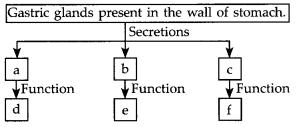
Answer: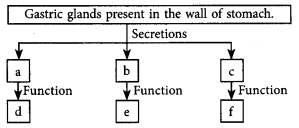
a – Hydrochloric acid (HCl)
b – Protein digesting enzyme pepsin
c – Mucus
d – HCl makes medium acidic for the activation of an enzyme pepsin.
e – Pepsin acts in acidic medium which breaks down proteins into peptones.
f – Mucus protects the inner lining of stomach from corroding action of HCl.
Question 6.
(a) State the role played by the following in the process of digestion :
(i) Enzyme trypsin
(ii) Enzyme lipase-
(b) List two functions of finger-like projections present in the small intestine. (2020)
Answer:
(a) (i) Enzyme trypsin : This enzyme is produced by the pancreas in an inactive form called trypsinogen. Trypsin converts remaining proteins into peptones and the peptones into peptides and amino acids.
(ii) Enzyme lipase : It is secreted by pancreas and small intestine. Lipase converts fats into fatty acids and glycerol.
(b) Internally, the wall of the small intestine is provided with long finger-like projections called villi. Two functions of villi are :
(i) The villi greatly increase the absorptive surface area of the inner lining of small intestine.
(ii) The large surface area of small intestine helps in rapid absorption of digested food.
Question 7.
Explain the significance of photosynthesis. Writd the balanced chemical equation involved in the process. (Board Term I, 2017)
Answer:
Photosynthesis is important for a number of reasons:
(i) Food : By photosynthesis, green plants synthesise food from simple raw materials like CO2 and H2O. Thus, it sustains life on earth.
(ii) Oxygen : Oxygen released during the process of photosynthesis is needed by animals and humans for respiration. It is also required for respiration of microbes. Oxygen also supports combustion of fuels.
(iii) Fuels : Fossil fuels like coal, oil and natural gas are forms of stored solar energy synthesised millions of years ago through photosynthesis. Balanced chemical equation involved in the process of photosynthesis is given as :
Question 8.
Differentiate between autotrophs and hetero- trophs and give one example of each. (Board Term 1,2017)
Answer:
Differences between autotrophs and hetero- trophs are as follows:
| Autotrophs | Heterotrophs |
| (i) These organisms are able to form organic substances from simple inorganic substances such as CO2 and H2S and water. | They cannot produce organic compounds from inorganic sources and therefore completely rely on consuming other organisms for its food requirement. |
| (ii) They have chlorophyll to trap solar energy. | Chlorophyll is absent, so they cannot trap solar energy. |
| (iii) They can be chemoautotroph and photoautotroph. | They can be saprophytic, parasitic and holozoic in mode of nutrition. |
| (iv) Autotrophs are placed at the bottom of the food chain as producers. | Heterotrophs are placed above autotrophs in the food chain as consumers. |
| (v) Green plants, some bacteria and some protists like Euglena are examples of autotrophs. | Mushrooms, Euglena, cow, goat, etc., are examples of heterotrophs. |
Question 9.
Explain with the help of neat and well labelled diagrams the different steps involved in nutrition in Amoeba. (Board Term I, 2015)
Answer:
The mode of nutrition in Amoeba is holozoic. The process of obtaining food by Amoeba is called phagocytosis.
- Amoeba ingests food by using its finger-like projections called pseudopodia.
- The food is engulfed with a little surrounding water to form a food vacuole inside the Amoeba. The food is digested inside food vacuole by digestive enzymes.
- Food is absorbed directly into the cytoplasm of Amoeba by diffusion.
- Food is used to obtain energy and growth of Amoeba.
- When considerable amount of undigested food collects inside Amoeba then its cell membrane ruptures at any place to throw out this undigested food.
Diagrammatic representation of different stages in the holozoic nutrition (feeding) of Amoeba is as follows:
Question 10.
(a) What is peristaltic movement?
(b) ‘Stomata remain closed in desert plants during daytime’. How do they do photosynthesis? (Board Term I, 2013)
Answer:
(a) The relaxation of gut muscles to move the partially digested food downwards throughout the alimentary canal is called peristaltic movement.
(b) In desert plants, stomata open at night and take in carbon dioxide (CO2). Stomata remain closed during daytime to prevent the loss of water by transpiration. They store the CO2 in their cells until the sun comes out so that they can carry on with photosynthesis during the daytime.
Question 11.
(a) Why is nutrition necessary for the human body?
(b) What causes movement of food inside the alimentary canal?
(c) Why is small intestine in herbivores longer than in carnivores?
(d) What will happen if mucus is not secreted by the gastric glands? (2020)
Answer:
(a) Human body continuously require energy for their life activities like respiration, circulation, excretion, etc. Energy is required even we are sleeping because a number of biological processes keep on occurring. All these processes require energy and this energy is obtained from nutrition. Nutrition is also needed for growth and repair of human body.
(b) The wall of alimentary tract contains muscles which can contract and expand alternately. The contraction and expansion movement of the walls of foodpipe is called peristaltic movement. The peristaltic movement moves the partially digested food in all the digestive organs throughout the alimentary canal.
(c) Herbivores eat plants which is rich in cellulose. Cellulose takes longer time for complete digestion by the enzymes present in symbiotic bacteria. Therefore, they have longer small intestine. Carnivores, feed on flesh which is easier to digest and do not contain cellulose also. Therefore, they have shorter intestine for digestion of food eaten by them.
(d) Gastric glands secrete HCl, mucus, rennin and pepsin enzymes. Mucus protects the inner lining of stomach from the action of HCl and enzymes. In the absence of mucus, there would be erosion of inner lining of stomach leading to acidity and ulcers.
Question 12.
(a) State the form in which the following are stored:
(i) Unused carbohydrates in plants.
(ii) The energy derived from food in humans,
(b) Describe the process of nutrition in Amoeba with the help of diagram. (Board Term I, 2016)
Answer:
(a) (i) Unused carbohydrates in plants are stored in the form of complex sugar known as starch. They are later broken down into simple sugars (glucose) when energy is needed.
(ii) The assimilated food molecules hold energy in their chemical bonds. Their bond energy is released by oxidation in the cell. This energy is trapped by forming bonds between ADP (adenosine diphosphate) and inorganic phosphate (Pi) to synthesise ATP (Adenosine triphosphate) molecules. These bonds are later broken by enzymatic hydrolysis and the energy released is utilised for cellular processes.
(b) Amoeba is a unicellular animal. Amoeba eats tiny (microscopic) plants and animals which float in water. The mode of nutrition in Amoeba is holozoic. The process of obtaining food by Amoeba is called phagocytosis. When a food particle comes close to Amoeba, it ingests the food particle by forming temporary finger-like projections called pseudopodia around it. The food is engulfed with a little surrounding water to form a food vacuole inside the Amoeba. The food is digested inside food vacuole by digestive enzymes and absorbed directly into the cytoplasm of Amoeba cell by diffusion. A part of absorbed food is used to obtain energy and the remaining part is utilised for growth of Amoeba. When considerable amount of undigested food collects inside Amoeba then its cell membrane ruptures at any place to throw out this undigested food. This process is called egestion.
Refer to answer 9 for figure.
Question 13.
Anaerobic process
(a) takes place in yeast during fermentation
(b) takes place in the presence of oxygen
(c) produces only energy in the muscles of human beings
(d) produces ethanol, oxygen and energy. (2020)
Answer:
(a) takes place in yeast during fermentation
Question 14.
Diffusion is insufficient to meet the oxygen requirement of multicellular organisms like human. State reason. (Board Term 1,2017)
Answer:
Due to higher metabolic rate and the volume of human body is so large that oxygen cannot diffuse into all cells of the body quickly as oxygen will have to travel large distances to reach each and every cell. So diffusion is insufficient to meet the oxygen demand of multicellular organisms.
Question 15.
Write two different ways in which glucose is oxidised to provide energy in human body. Write the products formed in each case. (Delhi 2019)
Answer:
The two different ways by which glucose is oxidised to provide energy in human body are:
(i) Aerobic respiration : The end products in aerobic respiration are carbon dioxide, water and energy.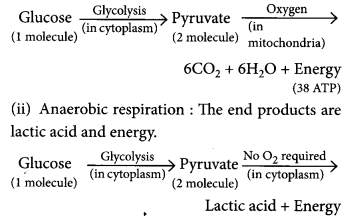
Question 16.
(a) In the process of respiration, state the function of alveoli.
(b) Rate of breathing in aquatic organisms is much faster than that in terrestrial organisms. Give reasons.
(c) Complete the following pathway showing the breakdown of glucose.
Answer:
(a) Functions of alveoli are :
(i) They increase the surface area for exchange of gases.
(ii) The thin walls of alveoli facilitate rapid exchange of oxygen and carbon dioxide between alveolar air and blood.
(b) Aquatic animals like fishes obtain oxygen from water present in the dissolved form through their gills. The amount of dissolved oxygen is quite small as compared to the amount of oxygen in the air. Therefore, to obtain required oxygen from water, aquatic animals have to breathe much faster than the terrestrial organisms.
Question 17.
Write three points of difference between breathing and respiration. (Board Term I, 2016)
Answer:
Differences between breathing and respiration are as follows:
| Breathing | Respiration |
| (i) It is a physical process. It involves inhalation of fresh air and exhalation of foul air. | It is a biochemical process. It involves exchange of respiratory gases and also oxidation of food. |
| (ii) It is an extracellular process. | It is both an extracellular as well as intracellular process. |
| (iii) It does not involve enzyme action rather two types of muscles are involved in this process. | It involves a number of enzymes required for oxidation of food. |
| (iv) It does not release energy, infact it consumes energy. | It releases energy. |
| (v) It is confined to certain organs only. | It occurs in all the cells of the body. |
Question 18.
Draw a flow chart to show the breakdown of glucose by various pathways. (Board Term I, 2016)
Answer:
Breakdown of glucose by various pathways:
Question 19.
Write three points of difference between respiration in plants and respiration in animals. (Board Term I, 2014)
Answer:
Differences between respiration in plants and animals are as follows:
| Plant respiration | Animal respiration |
| (i) All parts of plants, like roots, stem and leaves, perform respiration individually. | Animal performs respiration as a single unit. |
| (ii) There is little transport of respiratory gases from one part to the other during respiration. | Respiratory gases are usually transported over long distance inside an animal during respiration. |
| (iii) Respiration occurs at a very slow rate. | It is a fast process in animals. |
| (iv) There is no special gas transport system. | Gases are transported by specialised blood vascular system. |
| (v) Respiratory organ in plants are generally stomata in leaves, lenticels in stem and general surface of roots. | Respiratory organ in animals are generally lungs and gills. |
Question 20.
(a) Why is there a difference in the rate of breathing between aquatic organisms and terrestrial organisms? Explain
(b) Draw a diagram of human respiratory system and label – pharynx, trachea, lungs, diaphragm and alveolar sac on it. (2020)
Answer:
(a) Terrestrial organisms inspire atmospheric oxygen, while aquatic organisms thrive on the dissolved oxygen present in water. Air contains about 21% of oxygen while water has less than 1% oxygen in dissolved state. Oxygen diffuses through water at a much slower rate as compared to air. A terrestrial organism has the advantage of utilising greater amount of oxygen at a faster rate with lesser effort whereas, aquatic organisms have to put more effort to obtain the same amount of oxygen, therefore breathing in aquatic organisms is much faster than the terrestrial organisms.
(b) The labelled diagram of human respiratory system is a follows :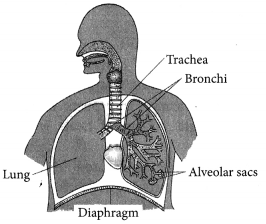
Question 21.
(a) State reasons for the following:
(i) Herbivores need a longer small intestine while carnivores have shorter small intestine.
(ii) The lungs are designed in human beings to maximise the area for exchange of gases.
(b) The rate of breathing in aquatic organisms’is much faster than that seen in terrestrial organisms. (Board Term 1,2016)
Answer:
(a) (i) Herbivores need a longer small intestine than that of carnivores because their diet is mostly grass and plants, that contains more fibres and cellulose which are hard to digest. Longer small intestine also hosts many small bacteria that process and break down cellulose into glucose which is a source of energy. Carnivores diet is not rich in cellulose so, they do not need to harbour bacteria for cellulose digestion.
(ii) Human lungs have a highly branched network of respiratory tubes. A primary bronchus divides into secondary bronchus, which in turn forms tertiary bronchus. Tertiary bronchus divides repeatedly into bronchioles which finally terminate into alveoli. Alveoli are small, rounded polyhedral pouches which are extremely thin- walled and possess a network of capillaries, for the exchange of gases. Due to vast surface area of alveoli, exchange of gases becomes a fast and effective process. Oxygen diffuses from alveoli into pulmonary blood capillaries and CO2 diffuses out from capillaries into alveoli.
(b) Refer to answer 20(a).
Question 22.
Draw a flow chart showing the three different pathways involved in the breakdown of glucose in different organisms. Name the respiratory pigment present in human beings. State the function of rings of cartilage present in our throat. (Board Term I, 2015)
Answer:
Refer to answer 18.
Respiratory pigment present in human beings is haemoglobin.
Rings of cartilage are C in shape, stacked one on top of the other. These cartilaginous rings prevent the trachea from collapsing and blocking the airway.
Question 23.
(a) Draw a diagram of human respiratory system and label: Trachea, Bronchi and Diaphragm.
(b) Give reasons for the following:
(i) Lungs always contain residual volume.
(ii) Nostrils are lined with mucus. (Board Term I, 2013)
Answer:
(a) Refer to answer 20(b).
(b) (i) Lungs always contain residual volume so that during the breathing cycle, when air is inhaled and exhaled, there must be sufficient time for oxygen to be absorbed and for the carbon dioxide to be released. It is also important as it prevents the lungs from collapsing.
(ii) Mucus and hair present in nostrils help in filtration of inhaled air. It traps harmful substances and germs present in air.
Question 24.
Which one of the following statements is correct about the human circulatory system?
(a) Blood transports only oxygen and not carbon dioxide.
(b) Human heart has five chambers.
(c) Valves ensure that the blood does not flow backwards.
(d) Both oxygen – rich and oxygen – deficient blood gets mixed in the heart. (2020)
Answer:
(c) Valves ensure that the blood does not flow backwards.
Question 25.
Name the vein which brings blood to left atrium from lungs. (Board Term I, 2017)
Answer:
Pulmonary vein carries oxygenated blood from lungs to left atrium of heart.
Question 26.
Define translocation in reference to plants. (Board Term I, 2016)
Answer:
The transport of food prepared in the leaves, by the process of photosynthesis, to various parts (roots, stem, branches, etc.) of the plant is called translocation.
Question 27.
Write three types of blood vessels. Give one important feature of each. (Delhi 2019)
Answer:
The three types of blood vessels in human body are: (i) arteries, (ii) veins and (iii) capillaries.
(i) Arteries are the blood vessels which carry blood from heart to various parts of the body. The walls of arteries are thick, elastic and muscular that enables them to dilate but not rupture when the heart contracts and forces blood into them.
(ii) Veins are thin walled blood vessels which bring blood from the body back to the heart. They are larger and hold more blood than the arteries. The lumen of veins are provided with valves to prevent the backflow of blood.
(iii) Capillaries are thin walled and extremely narrow blood vessels which occur at the terminals of artery and vein. The wall of capillaries are permeable to water and dissolved substances so that the exchange of materials between the blood and body cells can take place.
Question 28.
(a) Write two water conducting tissues present in plants. How does water enter continuously into the root xylem?
(b) Explain why plants have low energy needs as compared to animals. (AI 2019)
Answer:
(a) Xylem tracheids and vessels are two water conducting tissues present in plants that help in rapid movement of water. In xylem tissue, vessels and tracheids of the roots, stems and leaves are interconnected to form a continuous system of water conducting channels reaching all parts of the plant.
Minerals and water needed by the plants are absorbed by root hairs from the soil by the process of osmosis and take in minerals by the process of diffusion. Thus, a difference in concentration of ions is created between the roots and the soil which enables the water to enter into roots to compensate the difference in concentration. The water, alongwith dissolved minerals from root hairs, passes into xylem vessels through cells of the cortex, endodermis and pericycle and then ascent of sap (i.e., upward movement of water and mineral salts from roots to the aerial parts of the plant against the gravitational force) takes place from xylem of the roots to the xylem of stem and leaves through vessels and tracheids. Evaporation of water molecules from the cells of leaves creates a suction pressure which pulls the water from xylem cells.
(b) Plants are autotrophic and do not have to move from one place to another in search of their food. Movements in a plant are usually at the cellular level and hence they required less amount of energy. Whereas animals are heterotrophic and locomote in search of food and other activities, hence require higher amount of energy than of plants.
Question 29.
Explain how the translocation of materials in phloem tissue in plants is achieved by utilising energy. (Board Term I, 2017)
Answer:
The phloem cells transport the soluble food materials to all parts of plant. The transport of food from leaves to different parts of plant is termed as translocation. Components of phloem are sieve tubes, companion cells, phloem parenchyma and phloem fibres. The food is manufactured in the mesophyll cells (or photosynthetic cells) of a leaf. The manufactured food enters into sieve tubes of the phloem and is transported as a dilute aqueous solution either in upward or downward direction. Food is transported to all non-green parts of the plant for their growth and metabolic activities. Besides food molecules, phloem also transports amino acids, hormones synthesised in the shoot tips and root tips and other metabolites.
In this process, glucose is transferred to phloem tissue using energy from ATP. This increases the osmotic pressure of the tissue causing the water to move into it (endosmosis). Soluble material is then transferred from phloem tissue to other tissues which have less pressure than in the phloem. Thus, according to plants requirement, the material is translocated from higher osmotic pressure areas to lower osmotic pressure areas.
Question 30.
What do the following transport?
(i) Xylem
(ii) Phloem
(iii) Pulmonary vein
(iv) Vena cava
(v) Pulmonary artery
(vi) Aorta (Board Term I, 2014)
Answer:
(i) Xylem is a specialised plant conducting tissue that transports water and minerals from roots to all aerial parts of plants which occurs against gravitational force with the help of ascent of sap.
(ii) Phloem transports food that is prepared in the leaves, through photosynthesis, to various parts of plant. This process is called translocation. Phloem also transports amino acids, hormones synthesised in the shoot tips and root tips and other metabolites.
(iii) Pulmonary vein present in human circulatory system brings oxygenated blood from lungs to the left atrium of heart.
(iv) Vena cava transport deoxygenated blood collected by all veins of body except pulmonary vein and pass it to the right atrium of heart.
(v) Pulmonary artery transports deoxygenated blood from right atrium of heart to lungs for oxygenation.
(vi) Aorta transports oxygenated blood from left atrium to systemic arteries which further take the blood to various body parts and organs.
Question 31.
Explain giving any three reasons the significance of transpiration in plants. (Board Term I, 2014)
Answer:
Significance of transpiration in plants:
(i) The absorbed water is transported from roots to leaves through xylem vessels which is greatly influenced by transpiration pull.
(ii) The water stream moving upwards carries dissolved minerals with it. Transpiration also helps in distributing these minerals throughout the plant.
(iii) The evaporation of water during transpiration provide cooling effect to the leaves.
Question 32.
List in tabular form three differences between arteries and veins. (Board Term I, 2013)
Answer:
Differences between arteries and veins are as follows:
| Arteries | Veins |
| (i) Arteries are the blood vessels which carry blood away from the heart for distribution to the body. | Veins are blood vessels which bring blood from the body back to the heart. |
| (ii) Arteriei walls are thick and valves are absent. | Their walls are thin and valves are present to prevent back flow of blood. |
| (iii) Blood passing through narrow lumen of arteries is mostly oxygenated and has a considerable pressure. | The blood passing through wide lumen of veins is deoxygenated (except in pulmonary veins) and has low pressure. |
| (iv) More elastic and placed deeply. | Less elastic and superficially placed. |
Question 33.
Give reasons:
(a) Ventricles have thicker muscular walls than atria.
(b) Transport system in plants is slow.
(c) Circulation of blood in aquatic vertebrates differs from that in terrestrial vertebrates.
(d) During the daytime, water and minerals travel faster through xylem as compared to the night.
(e) Veins have valves whereas arteries do not. (2020)
Answer:
(a) Since ventricles have to pump blood into various organs with high pressure, they have thicker walls than atria.
(b) Transport system in plants is less elaborate than in animals, as plants are less active, so their cells do not need to be supplied with materials so quickly.
(c) The aquatic vertebrates like fish have gills to oxygenate blood. The flow of blood in a fish is single circulation because the blood passes through the heart only once in one complete cycle of body. The terrestrial vertebrates like birds and humans have double circulation as the blood travels heart twice in one complete cycle of blood and they have lungs for oxygenation of blood.
(d) It is because during daytime rate of transpiration is higher.
(e) The lumen of veins have valves, which allow the blood in them to flow in only one direction. Thus prevent back flow of blood.
Question 34.
(a) “Blood circulation in fishes is different from the blood circulation in human beings”. Justify the statement.
(b) Describe “blood circulation” in human beings. (2020)
Answer:
(a) Fishes have only two chambers in their heart, the blood is pumped to the gills to get oxygenated blood and from there it passes directly to rest of the body. Thus, the blood goes only once through the heart during one cycle of passage through the body. This type of circulation is termed as single circulation.
In human beings, during circulation blood travels twice through the heart in one complete cycle of the body and is called double circulation. The pathway of blood from the heart to the lungs and back to the heart is called pulmonary circulation and the pathway of blood from the heart to the rest of the body and back to heart is called systemic circulation.
(b) Deoxygenated blood from the body tissues is poured into right atrium. Contraction of heart forces it into right ventricle. From right ventricle, deoxygenated blood flows to the lungs through pulmonary artery. Oxygenated blood from lungs is returned into left atrium and then into left ventricle. The left ventricle forces the oxygenated blood to the whole body. Thus, for making one complete round or circulation circuit around all body parts, the blood passes through the heart twice. This is known as double circulation of blood.
Question 35.
(a) Mention any two components of blood.
(b) Trace the movement of oxygenated blood in the body.
(c) Write the function of valves present in between atria and ventricles.
(d) Write one structural difference between the composition of artery and veins. (2018)
Answer:
(a) Two components of blood are blood plasma and blood corpuscles.
(b) Deoxygenated blood gets oxygenated in the lungs, from there it moves to heart and pumped to different parts of the body. Its path can be traced out as
Lungs → Pulmonary veins → Left atrium of heart → Aorta → Arteries → Body parts
(c) When blood is pumped, valves prevent back flow of blood between ventricles and atria. They open and allow the right amount of blood to flow from one chamber to the other.
(d) Structural difference between veins and arteries is as follows:
Veins:
Veins have thin, less elastic and less muscular walls. They have valves to prevent back flow of blood.
Arteries:
Arteries have thick, elastic and muscular walls with no valves.
Question 36.
Draw a diagram of human excretory system and label kidneys, ureters on it. (Board Term I, 2017)
Answer:
Diagram of human excretory system is as follows: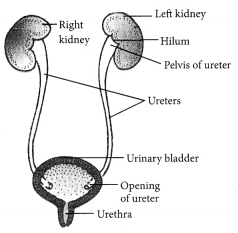
Question 37.
Draw a neat diagram of excretory system of human beings and label on it:
(i) Left kidney
(ii) Urinary bladder. (Board Term I, 2016)
Answer:
Refer to answer 36.
Question 38.
Describe the structure and function of nephron with the help of diagram. (Board Term I, 2014)
Answer:
Structure of nephron is as follows: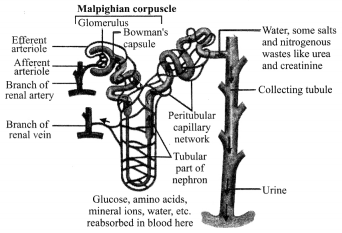
The function of nephron is filtration of blood and elimination of waste material from it. Blood is filtered from the blood capillaries into Bowmans capsule and pour the filtrate into the renal tubule. In this part, large amount of water and useful substances like glucose, amino acid, minerals ions, etc., are reabsorbed. Nitrogenous waste along with little amount of water is sent to the urinary bladder, which later expels the urine to the outside through urethra.
Question 39.
(a) Name four types of metabolic wastes produced by humans.
(b) Name any two human excretory organs other than kidney. (Board Term I, 2013)
Answer:
(a) Four types of metabolic wastes produced by human are urea, carbon dioxide, water and salts.
(b) Two human excretory organs other than kidneys are:
(i) Lungs : They help to eliminate carbon dioxide.
(ii) Liver : It is an excretory organ as it converts harmful amino acids to harmless urea and haemoglobin of worn out RBCs to bilirubin and biliverdin that can be excreted out of the body.
Question 40.
(a) Name the organs that form the excretory system in human beings.
(b) Describe in brief how urine is produced in human body. (2020)
Answer:
(a) Excretory system (Urinary system) in human beings consists of a pair of kidneys, a pair of ureters, urinary bladder and urethra.
(b) In the kidney, the wastes are converted to urine by three processes :
(i) Ultrafiltration : In it, large amount of water along with certain harmful substances like urea, uric acid, K+, ammonium salts, creatinine, etc., and certain useful substances like glucose, amino acids, Na+, etc., pass through glomerular capillaries and glomerular membrane into cavity of Bowman’s capsule of nephrons under pressure. The filtrate so formed is called nephric filtrate which is moved towards ureter.
(ii) Selective reabsorption : In it, large amount of water and sodium, whole of glucose and amino acids and small amount of urea are passed back from nephric filtrate into blood capillaries. It occurs either by back diffusion (i.e., water and urea) or active transport (i.e., Na+, glucose and amino acids). It generally occurs in PCT (Proximal convoluted tubule) of nephrons.
(iii) Tubular secretion : In this, certain harmful chemicals like uric acid, creatinine, K+, etc., are passed from blood capillaries surrounding the nephron into nephric filtrate by active transport. It generally occurs in DCT (Distal convoluted tubule) of nephrons. Now, the fluid is termed as urine and is excreted out of the excretory organs.
Question 41.
(a) Define excretion.
(b) Name the basic filtration unit present in the kidney.
(c) Draw excretory system in human beings and label the following organs of excretory system which perform following functions:
(i) form urine
(ii) is a long tube which collects urine from kidney
(iii) store urine until it is passed out. (2018)
Answer:
(a) The biological process involved in the removal of wastes, produced during various metabolic activities in the body from the body of an organism is called excretion. The wastes are non-gaseous nitrogenous wastes like ammonia, urea, uric acid, etc., along with excess of water, salts and pigments.
(b) Basic filtration unit present in kidney is nephron.
(c) Refer to answer 36.
(i) Kidney
(ii) Ureter
(iii) Urinary bladder
Question 42.
(a) Draw a neat diagram of the human excretory system and label following parts:
(i) Urethra
(ii) Kidney
(iii) Ureter
(iv) Urinary bladder
(b) What are nephrons ? How is a nephron involved in the filtration of blood and formation of urine? (Board Term I, 2015)
Answer:
(a) Refer to answer 36 for figure.
(b) Nephrons are the functional unit of kidney. Each kidney has about one million nephrons. Each nephron consists of a cup-shaped structure called Bowman’s capsule containing a bunch of capillaries called glomerulus. Bowman’s capsule leads into tubular structure which ultimately joins the transverse collecting tubule.
Filtration of blood and formation of urine in nephron involves the following steps:
(i) The blood along with waste and excess water is brought to kidney by renal arteries. Blood is filtered from the blood capillaries into Bowmans capsule.
(ii) As the nephric filtrate passes through the tubular part of nephron, useful substances like glucose, amino acid, mineral ions, water, etc., are reabsorbed by blood capillaries surrounding the nephron.
(iii) Tubular secretion occurs mainly in the renal tubule and the collecting duct of the nephron where additional wastes are excreted from the blood stream into the filtrate.
(iv) The fluid that flows through collecting tubule is urine which consists of water, urea, uric acid, mineral ions like sodium, potassium, chloride, phosphates, etc.
Question 43.
(a) Draw a well-labelled diagram of structural and functional unit of kidney.
(b) Explain the mechanism of the urine formation. (Board Term I, 2013)
Answer:
(a) Structural and functional unit of kidney is nephron. Its structure is as follows: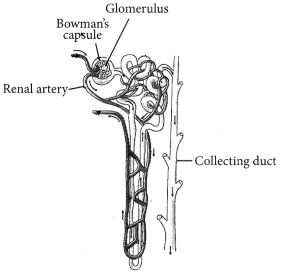
(b) Main function of nephron is to form urine. The three main processes involved in the urine formation are:
(i) Ultrafiltration: It is the filtration of body fluids and solutes from the blood, out of the glomerular capillaries into the Bowmans capsule due to the pressure of the glomerulus. All substances from the blood are filtered out except the large protein molecules and blood corpuscles. This fluid in the glomerular capsule is called glomerular filtrate. It consists of water, urea, salts, glucose and other plasma solutes.
(ii) Selective reabsorption : Glomerular filtrate contains a lot of useful materials like water, glucose and salts such as sodium. These substances are reabsorbed by blood capillaries surrounding the nephron from the renal tubule at various levels and to various extents.
(iii) Tubular secretion : This occurs mainly in the renal tubule and the collecting duct of the nephron. It is a process performed by the cells of the cuboidal epithelium lining the tubules which excrete additional wastes from the blood stream into the filtrate by active transport. In this process substances like potassium, hydrogen, creatinine and certain drugs like phenol, penicillin, etc., are directly excreted by the tubular cells from the blood. The fluid which now flows through collecting tubule is urine which consists of water, urea, uric acid, mineral ions like sodium, potassium, chloride, phosphates, etc.










